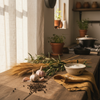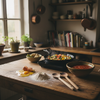Best Silicone Spatula For Scraping Bowls Tested
Key Takeaways
- The right silicone spatula helps scrape every last bit of batter from mixing bowls.
- Using a silicone spatula reduces waste and maximizes ingredient usage.
- A quality silicone spatula boosts confidence in the kitchen by improving efficiency.
- Silicone spatulas are essential tools for home chefs aiming for perfect results.
Table of Contents
- Why Every Home Chef Needs the Right Silicone Spatula for Scraping Bowls
- Anatomy of the Perfect Silicone Spatula for Scraping Bowls
- How Silicone Outperforms Wood, Metal, and Rubber for Bowl Scraping
- Bowl Scraping Techniques Only Pros (and DI ORO Customers) Know
- Best Silicone Spatulas for Scraping Bowls in 2025: Tested & Reviewed
- Which Spatula Size, Shape, and Set Is Right for Your Bowl (and Why It Matters)
- Maintenance & Troubleshooting: Keeping Your Silicone Spatula Forever-Clean and Damage-Free
- Advanced Bowl Scraping for Baking, Cooking, and Meal Prep
- Which Spatula Size, Shape, and Set Is Right for Your Bowl
Why Every Home Chef Needs the Right Silicone Spatula for Scraping Bowls
That last tablespoon of cake batter clinging to your mixing bowl? It's not just waste, it's potential. The right silicone spatula for scraping bowls transforms kitchen frustration into culinary confidence, ensuring every drop of your carefully crafted mixture makes it from bowl to pan.
For those seeking a seamless upgrade, the 3-piece seamless spatula set is designed to help you scrape every last bit from your mixing bowls, no matter the recipe.
If you frequently work with blenders or jars, consider the 2-piece seamless blender spatula + jar spatula set for tackling hard-to-reach corners and maximizing ingredient usage.
Anatomy of the Perfect Silicone Spatula for Scraping Bowls
![]()
A superior silicone spatula for scraping bowls starts with three non-negotiable features: seamless construction, pro-grade silicone, and a reinforced stainless steel core. This Wide Spatula for Baking with a seamless design eliminates bacteria-trapping crevices where two-piece spatulas fail, while the reinforced core prevents the frustrating bend-and-snap that ruins precision scraping.
| Feature | DI ORO Seamless | Why It Matters for Bowl Scraping |
|---|---|---|
| Blade Dimensions | 11.2" x 2.5" | Optimal width covers bowl curves efficiently |
| Weight | 3.2 oz | Perfect balance for control without fatigue |
| Heat Resistance | 600°F | Safe for hot mixtures and direct pan contact |
| Core Material | Stainless Steel | Zero flex under pressure, precise scraping |
| Certifications | LFGB, FDA, Forever-Chemical-Free | Highest safety standards for food contact |
Pro-grade silicone matters beyond heat resistance. LFGB certification, stricter than FDA standards, ensures the material won't leach chemicals into food, even under extreme conditions. DI ORO's forever-chemical-free formulation eliminates PFAS concerns, addressing health-conscious cooks' primary worry about synthetic kitchen tools.
How Silicone Outperforms Wood, Metal, and Rubber for Bowl Scraping
Material choice determines scraping success. While wooden spoons absorb flavors and harbor bacteria, metal scrapers scratch non-stick surfaces, and rubber spatulas degrade under heat, silicone delivers consistent performance across all cooking scenarios, making it easy to keep tools organized and dry on a Store Drying Rack.
| Material | Heat Resistance | Flexibility | Hygiene | Bowl Safety | Longevity |
|---|---|---|---|---|---|
| Silicone (Pro-Grade) | 600°F | Excellent | Seamless, dishwasher-safe | Won't scratch any surface | Lifetime with proper care |
| Wood | 300°F | Rigid | Absorbs odors, bacteria-prone | Can dent soft materials | 1-2 years with maintenance |
| Metal | High | None | Easy to clean | Scratches non-stick coatings | Excellent |
| Rubber | 200°F | Good when new | Degrades, traps odors | Safe for most surfaces | 6-12 months |
Silicone's molecular structure provides the ideal combination of flexibility and durability. Unlike rubber, which can crack or warp under temperature stress, silicone maintains its shape and performance across thousands of uses.
For more insights on choosing the right utensil, see our guide on silicone spatulas for mixing and scraping.
Bowl Scraping Techniques Only Pros (and DI ORO Customers) Know
Master these three professional techniques to transform your bowl-scraping game from wasteful to flawless.
The Bowl-Hugger Method: Position your spatula at a 30-degree angle against the bowl's curve. Apply gentle, consistent pressure while rotating the bowl counterclockwise with your free hand. The seamless edge should maintain contact with the surface throughout the sweep. This technique captures 99% of thick batters and doughs, perfect for cookie mixtures and cake batters where every bit counts.
The Lens Wipe Technique: For thin sauces and creams, hold the spatula perpendicular to the bowl bottom and work in overlapping circular motions from outside to center. The flexible silicone head conforms to the bowl's contours, collecting liquid residue that rigid tools miss. Finish with one smooth perimeter sweep to gather everything at the pour spout.
Pro Tip: The spatula's core rigidity determines scraping efficiency. DI ORO's stainless steel core provides the perfect balance, flexible enough to hug curves, rigid enough to apply effective pressure without bending.
The Corner Release: When sticky doughs cling to mixing bowl corners, insert the spatula's tapered edge at a 45-degree angle and twist gently while pulling away from the surface. The seamless design prevents dough from catching on joints or seams, ensuring clean release every time.
Best Silicone Spatulas for Scraping Bowls in 2025: Tested & Reviewed

After extensive testing across multiple kitchen scenarios, these silicone spatulas for scraping bowls deliver superior performance, durability, and safety standards.
DI ORO Seamless Silicone Spatula - The Gold Standard
Best for: Professional-grade bowl scraping with zero compromise on safety or performance
Winner of America's Test Kitchen's "Best All-Purpose Spatula" (see the review) and Food Network's "Best Spoonula" (see the feature), this spatula sets the benchmark for bowl-scraping excellence. The seamless, one-piece design eliminates bacteria traps while the 600°F heat resistance handles any cooking challenge. Pro-grade, forever-chemical-free silicone meets LFGB certification standards, the highest safety rating available.
For cooks who want a complete kitchen solution, the 5-piece seamless DI ORO spatula set offers a range of sizes for every bowl and recipe.
OXO Good Grips Silicone Spatula - The Comfortable Choice
Best for: Extended mixing sessions requiring ergonomic comfort
Pros: Cushioned handle reduces hand fatigue, dishwasher safe, moderate flexibility
Cons: Two-piece construction creates hygiene concerns, lower heat resistance (400°F), potential for handle separation
GIR Ultimate Spatula - The Colorful Option
Best for: Style-conscious cooks prioritizing aesthetics
Pros: Wide color selection, solid construction, good flexibility
Cons: Premium price without premium certifications, limited heat resistance (425°F), no lifetime warranty
| Feature | DI ORO Seamless | OXO Good Grips | GIR Ultimate |
|---|---|---|---|
| Construction | Seamless one-piece | Two-piece assembly | One-piece molded |
| Heat Resistance | 600°F | 400°F | 425°F |
| Safety Certification | LFGB + FDA | FDA only | FDA only |
| Core Material | Stainless steel | Plastic | Silicone-wrapped nylon |
| Warranty | Lifetime replacement | Limited satisfaction | 1 year |
Which Spatula Size, Shape, and Set Is Right for Your Bowl (and Why It Matters)
Matching your spatula to your most-used bowls maximizes scraping efficiency and minimizes waste. Size and shape directly impact performance, too narrow misses surface area, too wide can't navigate curves effectively.
Classic Large Spatula (2.5" blade): Ideal for stand mixer bowls, large mixing bowls, and wide saucepans. The broad surface covers maximum area per stroke while the tapered edge reaches into corners. Perfect for cake batters, bread doughs, and large-batch cooking where speed matters.
For professional bakers or those handling large batches, the Seamless Pro 14-Inch Large Silicone Spatula is engineered for maximum coverage and control.
To learn more about spatula selection for baking, check out our article on top rated seamless spatulas for baking.
Maintenance & Troubleshooting: Keeping Your Silicone Spatula Forever-Clean and Damage-Free
A quality silicone spatula for scraping bowls should last years with minimal care. The key lies in understanding what damages silicone, and what doesn't.
Daily Cleaning Protocol: Rinse immediately after use to prevent residue buildup. For dishwasher cleaning, place on the top rack away from heating elements. Hand washing with warm, soapy water works equally well and extends lifespan by reducing thermal cycling stress.
Odor and Stain Removal: Create a paste with baking soda and water. Let it sit on the spatula for 20 minutes, then scrub gently with a soft brush. For stubborn garlic or onion odors, rub with coarse salt and lemon juice before washing. White vinegar soaks eliminate mineral deposits from hard water.
Seamless Advantage: One-piece construction eliminates the crevices where bacteria hide in traditional two-piece designs. No joints mean no trapped food particles or hidden mold growth.
Storage Best Practices: Avoid cramming spatulas into overstuffed drawers where sharp edges can nick the silicone. Use utensil crocks or drawer organizers with individual slots. Never store wet, moisture trapped against other utensils creates bacterial breeding grounds.
Common Issues and Solutions:
- Edge nicks: Minor cuts don't affect performance, but deep gouges (over 3mm) compromise hygiene
- Warping: Usually caused by exposure to temperatures above rated limits, check your spatula's heat resistance
- Discoloration: Cosmetic only unless accompanied by texture changes or chemical odors
- Stiffening: Quality silicone maintains flexibility; brittleness indicates material degradation
DI ORO's lifetime warranty covers manufacturing defects and premature wear, reflecting confidence in their pro-grade silicone construction.
Advanced Bowl Scraping for Baking, Cooking, and Meal Prep

Professional techniques separate good cooks from great ones. These advanced methods maximize your spatula's potential while preserving delicate textures.
The Meringue Fold: Position your spatula at the bowl's edge, dive straight down to the bottom, then sweep across and up the opposite side in one fluid motion. Rotate the bowl 90 degrees with each fold. Complete incorporation takes 8-12 folds maximum, over-mixing deflates the foam. The seamless edge of a quality spatula glides without catching air pockets.
Caramel Scraping Mastery: Hot caramel demands heat-resistant tools rated to 600°F minimum. Use the spatula's flat edge to scrape crystallized sugar from pan sides back into the mixture. The flexible head conforms to curved surfaces while the reinforced core prevents bending under thick, viscous loads.
Cookie Dough Efficiency: For thick batters, use a "cutting" motion rather than stirring. Slice down through the mixture, lift and fold over. This technique prevents overworking gluten while ensuring complete flour incorporation. The spatula's edge acts like a bench scraper for portion control.
Pro Tip: When scraping roasted vegetables from hot baking sheets, angle your spatula at 45 degrees and use quick, confident strokes. Hesitation allows food to re-stick to cooling surfaces.
Meal Prep Applications: Batch cooking requires efficient cleanup. Use your silicone spatula for scraping bowls to transfer every drop of marinade, sauce, or dressing. The flexible head reaches into corners that rigid tools miss, reducing waste and cleanup time.
For smaller tasks or precision work, the Mini Spatula is perfect for scraping out jars and small bowls.
Risotto Technique: Constant stirring with a silicone spatula prevents scorching while maintaining the creamy texture. The heat-resistant material won't melt from prolonged contact with hot rice, and the smooth surface won't scratch non-stick pans.
For more on the science and safety of kitchen tools, see this external resource on kitchen product safety.
Which Spatula Size, Shape, and Set Is Right for Your Bowl
Matching spatula dimensions to your most-used bowls transforms cooking efficiency. Size matters for both performance and ergonomics.
Blade Width Guidelines:
- 2.5" wide: Stand mixer bowls, large prep bowls, family-sized batches
- 2" wide: Standard mixing bowls, saucepans, everyday cooking
- 1.5" wide: Small bowls, individual portions, precision work
- 1" wide: Jars, narrow containers, spice mixing
| Bowl Type | Recommended Spatula | Why It Works |
|---|---|---|
| Stand Mixer Bowl | Large Classic (2.5") | Covers maximum surface area |
| Saucepan | Standard Spoonula (2") | Curved edge matches pan shape |
For a versatile everyday tool, the Silicone Spoonula combines the best features of a spatula and a spoon, making it ideal for both mixing and scraping.
To explore more about seamless spatulas and their advantages, visit our post on seamless spatulas for smooth food handling.
For a broader overview of spatula types and their history, see the Wikipedia entry on spatulas.
Frequently Asked Questions
What features make a silicone spatula ideal for scraping every last bit from mixing bowls?
An ideal silicone spatula for scraping bowls features a flexible, tapered edge that conforms to bowl curves and a sturdy handle reinforced with a stainless steel core for durability and precise control. These elements work together to efficiently scrape every last bit of batter or mixture without bending or breaking under pressure.
How does silicone compare to wood, metal, and rubber spatulas in terms of heat resistance and hygiene?
Silicone outperforms wood, metal, and rubber spatulas with heat resistance up to 600°F, making it safe for hot mixtures and direct pan contact. Unlike wood, which can absorb bacteria, and metal, which can scratch cookware, silicone is non-porous, bacteria-resistant, and free of forever chemicals, ensuring superior hygiene and durability.
Why is seamless construction important in a silicone spatula for bowl scraping?
Seamless construction eliminates crevices where food particles and bacteria can hide, making the spatula more hygienic and easier to clean. This design also enhances durability by preventing weak points that can crack or separate over time, ensuring your spatula stays safe and reliable for thorough bowl scraping.
What maintenance tips help keep a silicone spatula clean and damage-free over time?
To keep your silicone spatula clean and damage-free, wash it promptly after use with warm, soapy water or place it in the dishwasher if dishwasher safe. Avoid using abrasive scrubbers or sharp tools that can nick the silicone, and store it away from direct heat sources to maintain its flexibility and longevity.




